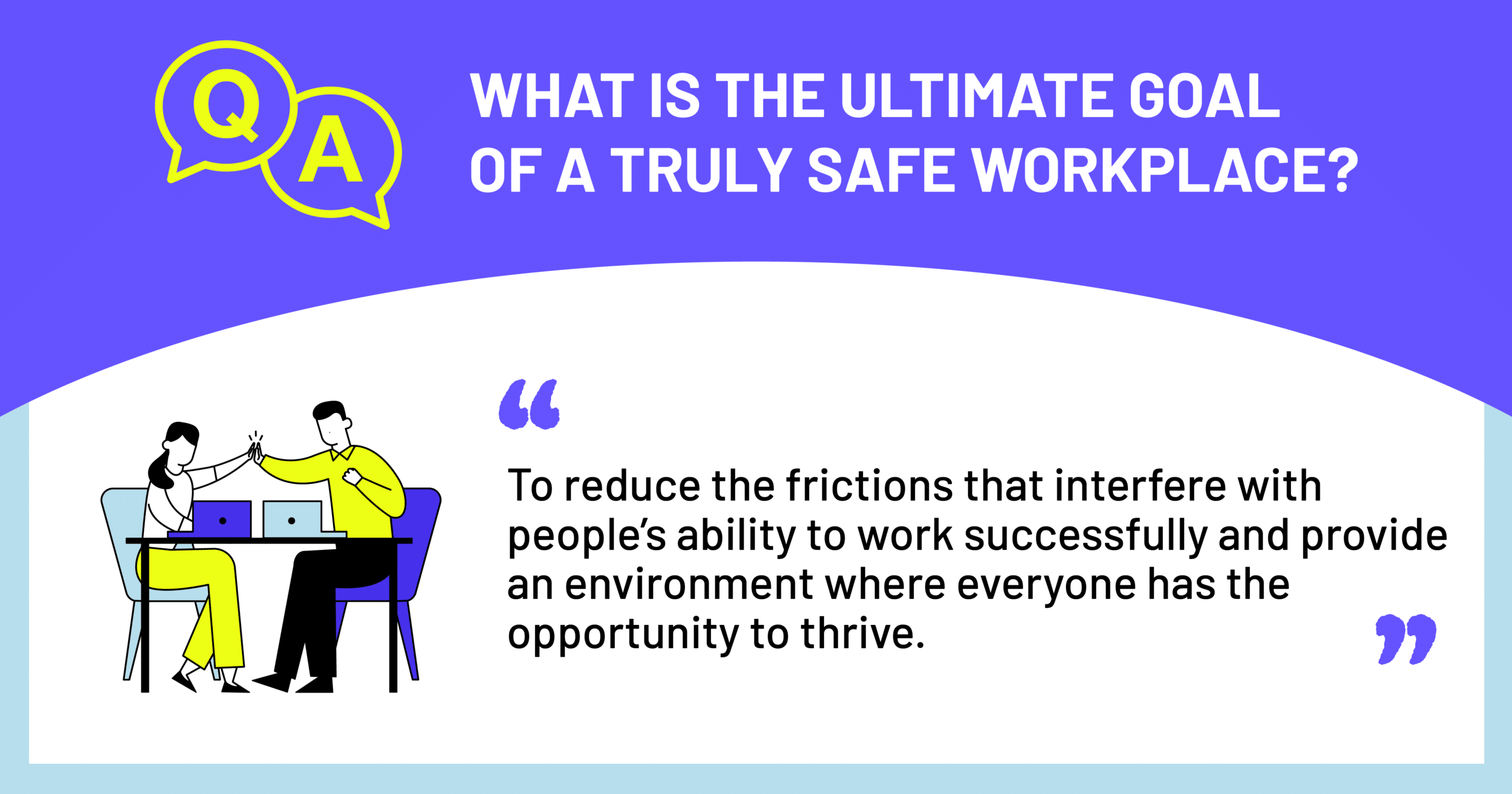When it comes to workplace safety, it’s no longer enough for offices to be merely “up to code”—they now have to be frictionless and adaptive to disruption.

As long as offices implement Universal Design Standards—guidelines that ensure workplaces and buildings are accessible to everyone, including those with and without disabilities and/or other conditions–providing a safe and up-to-code workplace, isn’t all that complicated. After all, these standards are well-defined and workplace strategists and designers have been working within these parameters for years.
However, as our cultural and social norms change, companies and their workplace teams now must look at office design through a human-centric lens. A safe workplace is now defined as a space where everyone has the opportunity to thrive and do their best work.
A frictionless office experience
Truly safe workplaces should provide a frictionless experience for all types of folks—native and non-native speakers of a language, tall people, short people, able-bodied people, people with deficiencies or disabilities, etc. Providing a safe workplace is about thinking through all of the different circumstances that someone might be facing when they’re in your office.
The goal of any workplace is to reduce frictions that interfere with people’s ability to work successfully. Every company has a great responsibility to think deeply about as many of these scenarios as possible and leave space for new ones as they emerge.
More often than not, offices create a ton of friction before people can even get to the point of being productive or being effective. And while human-centered design isn’t a silver bullet–you’re always going to find something to improve—by thinking about what office life is actually like for all the various types of scenarios people live in, uncovering what causes friction becomes a lot easier.
It’s about asking questions like:
- Can people in wheelchairs access the same things people who walk can?
- Do our spaces serve marginalized folks and minorities?
- Are things like countertops in break rooms and bathrooms too high?
- Are there enough nursing rooms for mothers who are coming back to the office?
- Do we have spaces that all people can use to briefly unplug and engage in activities like meditation?
For example, let’s say you send out an employee survey and a large demographic of your workforce says they’re distracted at the office and many feel they can’t focus.
This is very common. Over 70% of office employees feel distracted at the office which is one of the main reasons why people like working from home–it most of the time provides a reliable experience where they can focus without office white noise and distractions.
In this particular instance, ask yourself:
- Does our office have areas specifically designated for heads down work?
What if you repurposed a large area of your office to act almost as a library. A place where people can use it as long as they’re quite—no phone calls, conversations, etc. In communicating this, the purpose of this space—and not making exceptions to it—provides a reliable, frictionless experience for inhabitants.

Building flexibility and autonomy into the office experience
Removing friction from the workplace is a key axle on the wheel of making the office a truly safe space to be.
Adjacent to removing friction is building flexibility and autonomy into the workplace. While safety is a subjective feeling, flexibility makes us feel autonomous and autonomy makes us feel safe—many offices feel “too precious to break” to the point where folks feel like they’re walking on eggshells.
Pre-pandemic working environments were too rigid and this rigidity was a key factor in why 4.5 million people quit their jobs in September of 2021. Furthermore, many experts are saying that the Great Resignation isn’t over. A recent survey by Microsoft indicates that 52% of Millennial and Gen Z workers are likely to change employers within the next year.
As cultural and social norms evolve, implementing new understandings of worker expectations is a crucial aspect of the success of your workplace design and strategy.
Seventy-six percent of workers want flexibility in where they work and the offices we left at the beginning of the pandemic do not fit the flexible demands of the workforce. If companies want to “win” in our highly competitive, talent-centric job market and draw people back to in-person work environments, offices must evolve with the dynamic needs of people.
Walls don’t do that—fixed workstations can’t morph with changing demands. And as we’re seeing, most people who are coming into the office are doing so to socialize and collaborate with others.
Adaptability: The result of safe and flexible spaces
The future-of-work and the workplace is ambiguous—office design and workplace strategy must be an iterative process, not a static one.
Safe and flexible work environments are inherently adaptive—they’re nimble and more responsive to disruption because they evolve with people, their concerns, expectations, and accessibility needs. This is key for tackling the future workplace as adaptable workspaces can be reconfigured, on-the-fly, as spatial demands fluctuate over time.

Saltmine: Your central hub for your corporate building standards
According to one of Saltmine’s users, one of the biggest “aha” moments they’ve experienced when leveraging the platform is the ease of use when it comes to being “transparent when keeping spaces up to our corporate standards.” While every building has its own nuances, Saltmine allows users to pre-load their unique building standards, key design elements, and maintain consistency across the entire real estate portfolio–ensuring that every employee, no matter their office location, can have an equitable and accessible office experience. To learn more about how Saltmine can help you accomplish this, watch the video below:
Enjoying our blog? Be sure to subscribe to stay up-to-date on Saltmine's original content with the form below!



